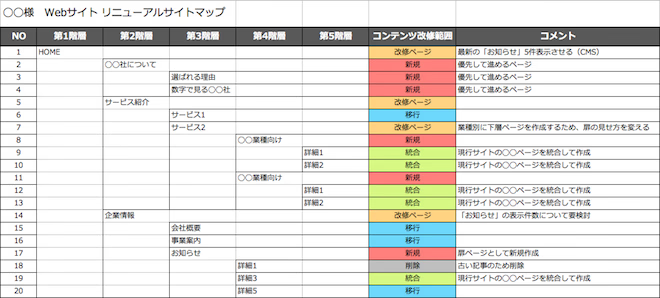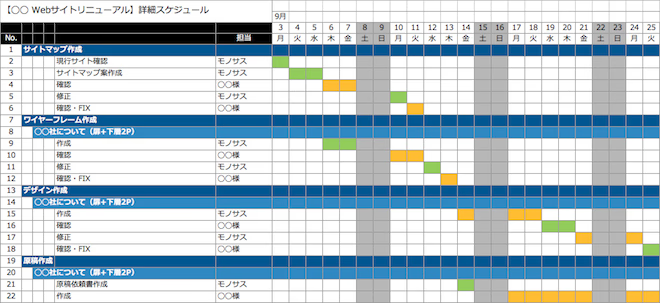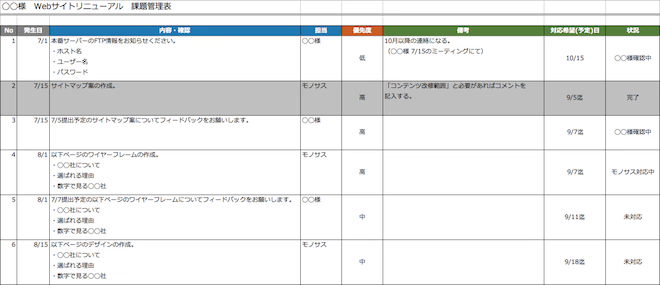Hello, I'm Director Oyabuchi.
When creating a website, sometimes things can get too busy to keep up with the deadline, causing all team members to get anxious, resulting in a so-called "firestorm."
Why does this happen?
Small daily delays pile up and have a lasting impact, clients make unexpected additional requests, things that should have been done are forgotten, the approach was poor to begin with... There are many possible causes, but when you look back, they are often surprisingly simple.
I believe that as long as you are conscious of trying to avoid this as much as possible, you can proceed with the production smoothly until the end. So, in this article, I would like to talk about the points to keep in mind when proceeding with the production so that you can proceed with the project with peace of mind and avoid "flaming."
I would like to divide the entire project into the "early stage" and "middle to late stage" phases and explain them in two parts. In the first part, I will introduce five points about the "early stage" when the project starts.
The beginning is crucial!
Five things to do early in a project
The beginning is the most important part of anything, so here are five things you should do in the early stages of a project. These are all obvious things, such as sharing information, creating a site map, organizing tasks, creating a schedule, and creating a task management table, but it's important to do each of them carefully.
1. Share requirements and proposals in advance at an internal meeting
In many cases, such as when a competition is held among multiple companies, we make a proposal to the client before production begins. For example, in a competition, we may spend about a month finalizing the plan and creating the design.
During the preliminary proposal process, only a few members are usually involved, so once the order is officially accepted and new production members are assigned, project-related items are shared.
What to share : Reconfirm and share requirements from the client.
・Sharing of proposed plans and proposals.
The important thing here is to "share it with all members," not just new members.
Why is sharing necessary for everyone? There are three reasons for this:
- Having everyone give their opinions and discuss them can lead to additional or better ideas.
- This will be an opportunity to decide in some detail who will be responsible for what.
- By making sure all members are on the same page and on the same page, questions and uncertainties are less likely to arise in subsequent work.

This sharing forum is the most upstream process after the project starts, so it is important to handle it properly. If there is a difference in understanding between production members or an oversight here, it will cause problems in later processes and will likely require schedule changes or emergency measures.
Also, in order to prepare for the kick-off meeting with the client that will follow, it is important to conduct the pre-meeting carefully. Since all the project members on the client's side are often present at the kick-off meeting, the more thorough the preparation, the smoother the discussion will go and you will be able to get off to a good start.
2. Create a sitemap
The work varies depending on the project, such as a full site renewal or partial renovation, but we always create a site map for all pages in the production scope. Creating a site map is a very common practice, but here we will go a little further and assign the following status to each page on the site map.
Status types・New page: A new page that does not exist on the current site ・Renovated page: A page that will be partially or completely renovated ・Transitioned page: A page whose design will be changed but whose content will remain the same as the current page ・Integrated page: A page that will be merged with another page ・Deleted page: The entire page will be deleted

Enter the status of each page in the "Content Revision Scope" column
The "new pages" will be decided based on the planned content, and the production team will first decide on all pages except for those that are unclear, and then finalize the final site map in consultation with the client.
Because "deciding the site map = deciding the site structure," the contents of the site map will be the basis for the design of the page framework (header, footer, side menu for each level, etc.) that will be created later. On the other hand, if you proceed without a solid site map, it may have a big impact, such as having to reconsider the framework design.
It is also important to decide the status of each page. By visualizing the status, it becomes easier to imagine the overall production volume, and how many pages require what level of attention. Of course, pages may be added or removed during the project, but if you decide on the general framework at the beginning, it should not have a significant impact later on.
In any case, don't proceed further until your sitemap is finalized.
3. List the issues
Next, we will identify and list all the issues that will arise from the start of the project to its release. It is important to list issues from both the production side and the client side here. It may be difficult to list all the issues, but we will list all the ones that are visible at the moment.
Once you have decided on one issue, make a list of issues related to it.
Example) If the assignment is to create a manuscript for a client: ・Create a wireframe for the page ・Client confirmation ・Modify the wireframe ・Client confirmation (FIX)
・Create manuscript request materials (based on wireframes, including character limits for each part)
・Client manuscript creation
This may seem like a lot of detail, but by making a list like this, you can organize things and prevent oversights. Making a list also requires a "simulation" at the time of production. By simulating here, you can see even more details about "who is responsible for what" that were not clear in the pre-meeting. Sometimes you can realize that there was a big gap and realize, "This was also necessary."
Also, listing the tasks will be the basis for the schedule and task management sheet that you will create later. In other words, I think it is so important that you cannot create a schedule or task management sheet without listing the tasks.
It takes time to make a list, but it's something you need to do.
I recommend it because it gives you peace of mind knowing that "this is all it takes to complete the project."
4. Create a schedule
Next, we create a schedule for the entire project to be shared with the client and internal members. Based on the issues listed above, we decide on a chronological schedule for each issue, taking into account the processes before and after each issue.
The "things to do" items are visible because they are listed, so all you have to do is schedule them so that they are completed in time for the site's launch, but it's important to decide on each item one by one while keeping in mind a "realistic time frame."

We schedule the work in consultation with each production staff member regarding the period of time required, and once the work is complete, we share it with the client and internal members and get agreement from each staff member on the content and time required.
By creating a schedule, you can clearly see what needs to be done and when. Even if it is difficult to deal with something in a time frame, it will be easier to come up with early countermeasures, such as securing additional resources or reconsidering the system.
Also, once the schedule is finalized, the man-hours for each person in charge are almost clearly visible, so you can feel secure that "if we proceed according to this schedule, the project will be completed." (As I said earlier, this sense of security is very important for a director. lol)
5. Create a task management table
The last of the five things to do in the early stages is to create an issue management table to be shared between the client and internal members. This will also be based on the issue list mentioned above, and will be created in a way that makes it easy to update the issue status and share it with the person in charge.
For example, you can provide the following information for each task:
- Will this be an issue for the client or for the production side?
- What is the current status of the issue? (Not yet resolved, in progress, completed, etc.)
Response priority.
- What is the deadline for response?

The important thing is to update the status of the issues whenever there is progress and share it regularly with the company and the client. By doing so, you can always align your understanding of the remaining issues and the issues that need to be addressed now, prevent any oversights, and prepare for future issues.
Although the tasks in the task management sheet and the items (tasks) on the schedule are linked, they are used for different purposes.
・Issue management table: Confirm the specific content and volume of the issues to be addressed ・Schedule: Manage and confirm timelines, such as the timing of issues to be addressed and priorities (speed)
By managing both the task management table and the schedule, even if there are changes to the schedule, you can check the issues that will be affected and efficiently consider when you can deal with them. Also, even if the number of issues increases, you can check the schedule and consider the impact on other issues, and when you can deal with them and bring them to a situation where they can be resolved immediately.
Changes in schedules and additional challenges are bound to occur.
The important thing is to avoid confusion when such a situation arises, and to create a situation in which a solution can be found as quickly as possible. I think that is the key to progressing a project smoothly.
What did you think of these five things you should do in the early stages of a project?
Each of these things may seem obvious, but the progress of the project depends greatly on how carefully you do them. I think the director's skill is shown in how much you can put together in the early stages.
Next time, we will talk about points to be careful of from the middle to the end of a project.

